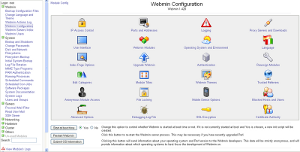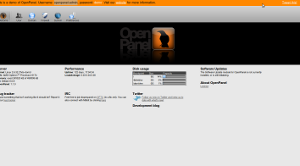Devo dire che in generale sono contrario alle interfacce grafiche per l’amministrazione del sistema, tanto più quando si tratta di server.
Però per i meno esperti, in casi speciali o semplicemente per facilitarci la vita è comodo ogni tanto utilizzare delle interfacce Web per la gestione di applicazioni o addirittura dell’intero server, e su Linux è possibile scegliere tra alcuni prodotti che sono sviluppati ormai da anni ed hanno raggiunto un alto livello di funzioni e possibilità di gestione.

Webmin
Penso che Webmin sia il più famoso strumento di questa categoria, la prima versione risale addirittura al 1997, mentre l’ultima ad agosto 2011, quindi ha una grande base utenti ed è attivamente sviluppato.
Tutte le versioni recenti di Webmin sono rilasciate sotto una licenza BSD-like, nel senso che può essere liberamente distribuito e modificato per l’uso commerciale e non commerciale.
Webmin è distributio con pacchetti .deb per Debian, Ubuntu ed altre distribuzioni che usano questa tipologia di pacchetti, .rpm per Redhat, Fedora, CentOS, SuSE o Mandrake o come .tar.gz per le altre distribuzioni.
Per la lista completa delle distribuzioni ufficialmente supportate guardate questo link
Webmin è in gran parte basato sul Perl, usando un proprio processo ed un web server. Il valore predefinito è la porta TCP 10000 per la comunicazione, e può essere configurato per utilizzare SSL se OpenSSL viene installato ed aggiunti alcuni moduli Perl necessari.
Con Webmin è possibile configurare gli account degli utenti, Apache, DNS, file sharing, account FTP, database MySQL e molto altro ancora. Webmin elimina la necessità di modificare manualmente i file di configurazione di Unix come /etc/passwd, e consente di gestire un sistema dalla console o in remoto.
Una cosa ottima di Webmin è la sua struttura modulare, ovvero dopo aver installato il core è possibile scegliere di aggiungere dei moduli da una lunghissima lista di 113 moduli standard, e ci sono almeno altrettanti moduli di terze parti, ognuno dei quali (una volta installato) permette di configurare e gestire uno specifico servizio.
Il software è ben documentato e l’installazione dovrebbe girare senza problemi sulla maggior parte dei sistemi, una cosa importante fare dopo l’installazione è quella di configurare Webmin per utilizzare https con un porte personalizzate, per aumentare il livello di protezione del server.
Per vedere Webmin in azione, potete usare il demo server al link :
http://webmin-demo.virtualmin.com/
L’username è demo , e la password è demo.
Software correlato
Ci sono altri tre progetti importanti che ampliano le funzionalità di webmin:
- Usermin presenta e controlla un sottoinsieme delle funzionalità disponibili in Webmin, come webmail ed altri compiti a livello utente, piuttosto che i compiti a livello di amministratore.
- Virtualmin, che è un pannello di controllo per gestore di domini e siti web, che dà la possibilità di creare e gestire i domini.
- Cloudmin Si tratta di una interfaccia utente costruita su Webmin per la gestione di sistemi virtuali, come Xen, KVM e istanze di OpenVZ
Kloxo
Kloxo (precedentemente noto come Lxadmin) è un pannello di controllo opensource per il web hosting per le distribuzioni Linux: Red Hat e CentOS.
Kloxo consente agli amministratori dell’hosting di utilizzare lighttpd o Apache con djbdns o bind, e fornisce un’interfaccia grafica per passare da uno all’altro di questi programmi senza perdere i dati. E’ noto anche come una buona alternativa gratuita al pannello di controllo cPanel hosting.
Kloxo viene integrato con Installapp, che è una collezione di circa 130 applicazioni web che possono essere installate sui siti ospitati. E’ supportato da Installatron, un programma di terze parti per l’installazione di applicazioni, in parte simile a Fantastico, come plugin.
Una volta installato è possibile connettersi con il protocollo http e https (quest’ultimo è quello da usare).
Anche per Kloxo c’è un sito di demo, che potete trovare qui
Quindi Kloxo fa molto meno cose di Webmin, ed è utile solo se si utilizza Red Hat o CentOS, ma può essere uno strumento utile per semplificare il vostro lavoro se si ospitano molti VirtualHost di Apache/Lighttpd, può installare facilmente un bel po di applicazioni e questo software è anche famoso per la poca memoria utilizzata mentre è in esecuzione.

Openpanel
OpenPanel è un pannello di controllo open source. OpenPanel è una piattaforma adatta agli sviluppatori. Perché è estremamente aperta e modulare che può essere utilizzata per controllare qualsiasi processo su un server Linux. OpenPanel offre tutti i servizi di hosting di base per la creazione di domini, tra cui DNS, e-mail, siti web e database. Un sistema di autenticazione a più livelli consente all’amministratore di creare account con limitazioni specificate per gli utenti finali. Tutti gli utenti del sistema sono in grado di controllare la configurazione del sistema utilizzando una interfaccia grafica intuitiva e una potente shell a linea di comando per la configurazione.
E’ incluso anche un modulo per la gestione del firewall con iptables, un utile add-on.
Si tratta di un nuovo progetto che si sta evolvendo molto velocemente, ciò che mi piace del progetto è che hanno in mente una chiara roadmap , e questa è sempre una buona cosa per un progetto, la cosa brutta è che il rilascio attuale è stato sviluppato principalmente su Ubuntu 10.04, ma è stato testato anche su Debian 5, Debian 6 ed Ubuntu 10.10. Le altre distribuzioni sono fuori dagli obiettivi di questo software.
Potete fare un test anche di questo software sul loro sito Demo
SysCP
SysCP (“Pannello di controllo di sistema”) è un software per l’amministrazione di server web basato e scritto in PHP e MySQL. Offre un front-end web-based per i clienti dei fornitori di servizi web, permettendo loro di gestire i loro indirizzi e-mail, domini e database.
Il progetto è stato avviato nell’autunno del 2003 da Florian Lippert. Dal 15 Giugno 2004 i contributi e tutto lo sviluppo è rilasciato sotto la licenza GNU GPL. Il software contiene modelli di configurazione per l’uso con Debian, Ubuntu, openSUSE e Gentoo Linux, ma è possibile eseguirlo su qualsiasi sistema che abbia PHP/MySQL come ad esempio FreeBSD. I servizi supportati sono (tra gli altri) server HTTP Apache, lighttpd, MySQL, PHP, Postfix e Courier o Dovecot come Mail-Services, Bind9 come nameserver. Ulteriori servizi e le estensioni possono essere integrate perfettamente con la configurazione dei servizi amministrati con SysCP, ad esempio ClamAV, Spamassassin e molti altri.
Purtroppo il progetto sembra essere abbandonato da qualche tempo, l’ultima release è un aggiornamento di sicurezza del maggio 2010, e molti link del sito ufficiale, sono ora rotti, come ad esempio tutta la documentazione, quindi per farla breve, non utilizzatelo.
Conclusioni
Devo dire che non sono così soddisfatto di questa raccolta di frontend web per la configurazione di Linux, l’unica soluzione completa che ho trovato è Webmin, e la maggior parte della gente dice che aiuta un po’, ma per alcuni moduli è solo una interfaccia web ad un vi/emacs ad un file di configurazione, così non aiuta i principianti a configurare correttamente un server.
Kloxo e Openpanel possono essere una buona alternativa per un compito specifico, ovvero se si hanno un sacco di VirtualHost e si vogliono vendere questo servizi, questi due software possono rivelarsi molto utili.
Popular Posts:
- None Found


Bell’articolo, non ero a conoscenza di gran parte di queste interfacce web 🙂 Peccato che sul mio serverino giri cherokee al posto di apache e non è supportato da nessuno altrimenti un test glielo facevo fare…
Webmin ha un Web Server a se stante e funziona indipendentemente da Apache o Cherokee
(Webmin is largely based on Perl, running as its own process and web server. It defaults to TCP port 10000 for communicating, and can be configured to use SSL if OpenSSL is installed with additional required Perl Modules.) Io ad esempio lo utilizzo da diversi anni e seppur interfacciato con il mio server Apache (come proxy in questo caso) lo potrei benissimo utilizzare accedendovi tramite la porta predefinita o un’altra (configurabile).
Ciao
Ho trovato anche questo pannello che sembra interessante anche se è ancora in fase di sviluppo, io lo terrei d’occhio 🙂
Cmq sono rimasto stupito che webmin supporti arch linux col suo package manager, pensavo di essere tra i pochi che utilizzassero questa distro da server 😛
Effettivamente Ajenti promette bene come software, nel senso che non copre solo la parte Web come altri prodotti ma ha anche plugin specifici sulla gestione del sistema.
Al momento mi pare sia disponibile solo per Debian.
Grazie per la segnalazione
Ciao
Bell’articolo… però IMHO a webmin preferisco gosa: https://oss.gonicus.de/labs/gosa/
ps: nei repo di ubuntu si trova tutto pacchettizzato per gosa: http://packages.ubuntu.com/search?keywords=gosa&searchon=names&suite=natty§ion=all
Ormai ho abbandonato queste soluzioni, Webmin è troppo dispersivo, gli sono invece troppo verticali (ma non conoscevo gosa).
La soluzione che ho trovato PERFETTA per le esigenze dei miei clienti è zenthyal, una derivata ubuntu (basata sulle LTS) con una GUI OTTIMA, semplice, ordinata e precisa.
Inoltre a differenza di questi altri strumenti automatizza (grazie ad ottimi script) varie funzioni. Per i piccoli/medi clienti che non hanno grandi budget è perfetta!
Grazie per la dritta, avevo già sentito parlare di Zentyal, e con l’occasione ho scritto un piccolo articolo introduttivo 😉
Nice, thanks for this. I always prefer the CLI, but it is nice to know about this.
These kind of tools may help when you are trying to convert more people to Linux, specially with those that are afraid of CLI.
Well, what about virtualmin / cloudmin?
It’s based on webmin and a really good interface for managing shared hosting.
check http://www.virtualmin.com/
check http://www.ispconfig.org